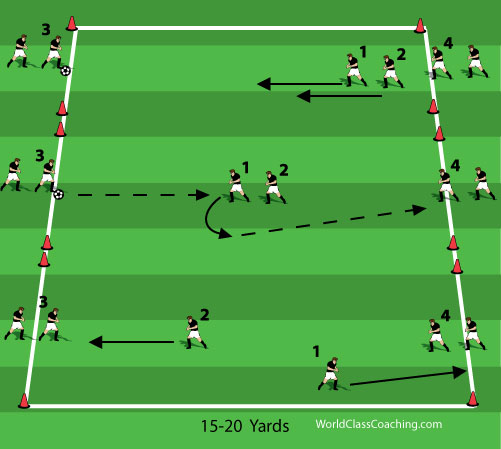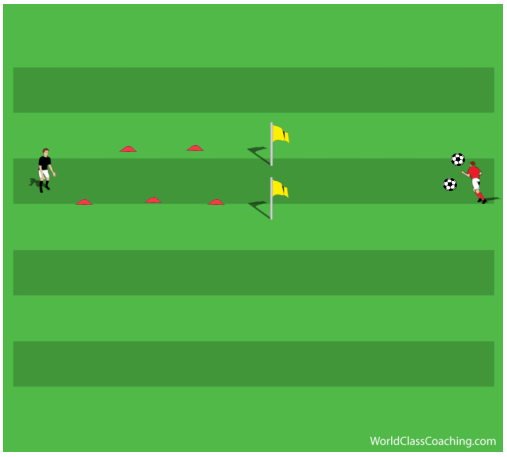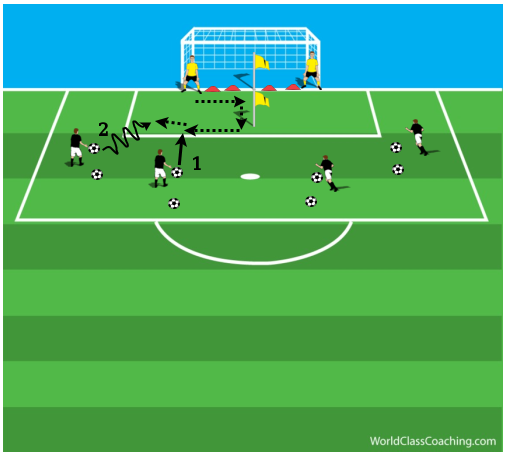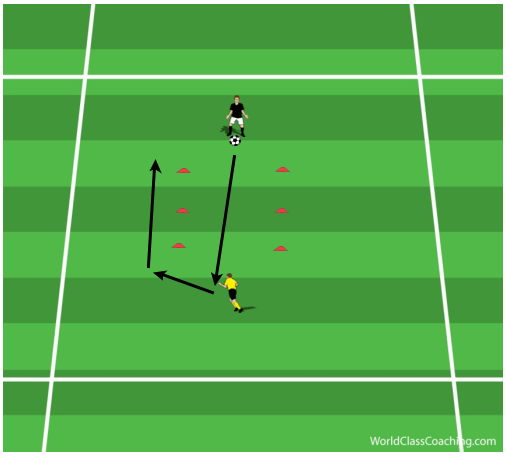Tag Archives for " technical "
- Home
- technical
Four Grid Game
By Alex Trukan This practice is a fun game that can suit all age groups, ability levels and can be adapted in many different ways. From a conditioning point of view, high intensity, short periods of work are designed to develop sprinting power that can be repeated in the game as many times as possible.
Continue reading#039 The Foundation of Effective Defending
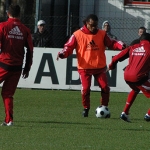
Click Here to Listen to Podcast Click Here for the Show Notes
Continue readingHow to Start Your Shooting Sessions
One of the perks of being apart of WORLD CLASS COACHING is that I have access to a large library of training sessions from some of the top professional, collegiate, and youth coaches. We have published books and videos on every aspect and topic of coaching.
I often refer to our videos especially for new ways to approach topics to keep my coaching fresh and interesting to the players I work with. I think we’re all probably guilty of using the same few drills or exercises for a specific technique over and over. This can be a good thing because it allows us to focus on teaching the game rather than having to spend a lot of time teaching the drill. But changing things up on occasion can breath new life into a stale session and
Continue readingSwitching Play Possession Game
By Alex Trukan The Switching Play Possession Game is highly engaging and high intensity game aimed mainly at more advanced players of higher ability. It helps to develop power to recover what helps in producing anaerobic actions more often. The practice strengthens aerobic energy system which generally acts as a platform to all football actions.
Continue readingAerobic Passing Game
By Alex Trukan
This practice have multiple outcomes in the technical corner including passing, receiving as well as movement off the ball. In addition to that, it develops the capacity of the body to recover quickly, what will lead to producing more high intensity actions throughout the game. That happens due to development of aerobic energy system. The practice can be well adapted to different age groups, number of players and ability levels.
Set up and directions
Set a square of approximately 15 x 15 yards, then further divide it into four smaller squares by putting a cone in the middle of it. Organise a group of players inside the
Continue readingRepetitive Turning Exercise
I like using high energy, repetitive exercises for skill training. They engage the players and give them a lot of opportunities to practice a skill that we have worked on before.
One of my favorites is Tag Turning.
Basic Pattern
- Two lines of players are facing each other
- One player has a ball (Player 3)
- A player from the opposite line starts in the middle (Player 1)
- Player 1 goes back toward his line and tags the next player (Player 2)
- Player 1 then checks back toward the ball and Player 3
- Player 2 follows closely behind
- Player 1 calls for the ball and Player 3 passes it to him
- Player 1 receives the ball and turns around Player 2 using one of the four turns taught earlier
- Player 2 then moves to tag Player 3 while Player 1 passes to Player 4 and the pattern continues
Dutch Passing Pattern
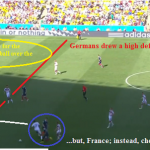
By Renato Lopez Moreira -
These exercises are based on Dutch training methods. The Dutch are considered one of the most technical in the world.
The exercise is a 4+2 player’s game.
The focus on this exercise is on maintenance of ball possession, player’s movement and exchange of quick passes.
The exercise is completed in a 15 x 12 yard area. Each player is limited to two touches on the
Continue reading#035 11 Different Diamond Drill Variations
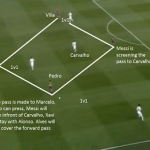
Click Here to Listen to Podcast Click Here for the Show Notes
Continue reading#032 How to Transfer Training into Matches

Click Here to Listen to Podcast Click Here for the Show Notes
Continue readingShoot 'n Save
By Jason Stockmann -
Getting players to help each other train while at a practice is an invaluable tool for multiple reasons. First and foremost, from a coaching perspective, it can relieve some of the time-crunch pressures we face by letting some players do their own thing while we focus on other aspects; it also lets us impart a sense of responsibility for personal development on the players themselves. From their perspective, this responsibility looks like a bit of freedom and control over their own soccer destiny…and it is a fun and subtle method to increase team cohesion.
I’m a firm believer that this player-to-player training is especially helpful when it is done with goalkeepers. Whether at a practice or during pre-game warmups, two goalies working with each other not only potentially frees up coaching resources, but
Continue readingStay on Target
By Jason Stockmann -
Too often it seems that when coaching younger ages and planning practices we forget a major element of the game – goalies. Sure, we send them to goalie-specific training when offered and we have good intentions by not pigeon-holing a kid as only a goalie at that young of an age, but we all still have those couple of kids that tend to be our main goalies. We train the team in defense, offense, set pieces, etc. – so why do we not work more with the keepers as well?
In all honesty, this is most likely due to lack of time, skill and/or extra help at practices. But I refuse to take that as the answer and just let the goalies flounder on their own – they need help from us and they need to work with their teams. Working with the team on drills helps out in two solid ways by letting the keepers show off their own skills (building confidence) and lets the field players see that they can trust their keepers. This keeper-field player trust is a huge aspect of the
Continue readingFootwork and Handling in the Warm-Up
By Tony Englund -
Goalkeeping warm-ups typically feature isolated handling and footwork exercises, and one of our points of emphasis in our club setting is to roll these two elements together in the warm-up to create more efficient and realistic training. This article features a trio of simple, favorite means of mixing these critical elements in the warm-up.
#1: Zig-Zag and Save
The goalkeeper does footwork through the
Continue readingGiving Players Confidence to Go 1 v 1
I've seen coaches run sessions that work on executing fakes and moves. Then when I watched the team play there was no sign of any moves. Why bother working on them if the players aren't going to use them in the game?
If you ask players why they don't try the moves in games they'll tell you that they are afraid of making a mistake. That tells me that the coach has not built confidence to actually use the moves into his or her session.
It's not complicated or difficult to build the confidence needed to use the moves in the game but as with all confidence it must be built on success.
This simple progression will help your players become more
Continue readingDealing with Break-Aways Part 2
By Tony Englund -
When I give goalkeeper training sessions to coaches, many ask about teaching their goalkeepers to deal with break-aways. In the first of a two-part article on the subject, we looked at building the goalkeeper’s confidence in blocking and closing down. In this second portion, tips for dealing with the break-away situation in match-like situations will be shared.
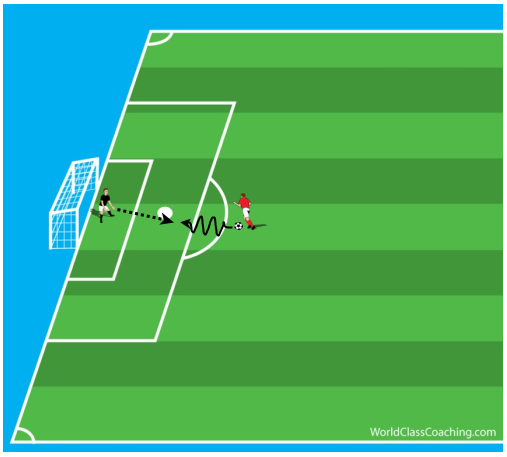
Break-Aways – Straight On The attacker starts his run from 25 yards before goal. To begin with, all break-ways are straight on to
Continue readingDealing with Break-Aways
By Tony Englund -
When I give goalkeeper training sessions to coaches, many ask about teaching their goalkeepers to deal with break-aways. In the first of a two-part article on the subject, we’ll look at building the goalkeeper’s confidence in blocking and closing down. In the second portion, tips for dealing with the break-away situation in match-like situations will be shared.
It is useful to invert the break-way situation as a teaching model, looking at the final, blocking save as a start point. Young goalkeepers in particular often hesitant to get into the feet of the attacker, though this gives them the
Continue readingMotivation to Score
I've always had a standing challenge to my teams (U13 and below), if they score a headed goal, I buy ice cream for the next practice. It's been a way to encourage the players to try and score with their head if they can. This has been most successful with the girls teams I have coached. The extra incentive has become something that the team rallies around.
After spending a few weeks working on our combination play to score we played very well in our next games. Two of our three goals came from combinations in the middle of the field.
Another area that I've wanted to address
Continue readingCombating Complacency
By Tony Englund -
Experienced, advanced goalkeepers sometimes fail to train on their edge if they are continually subjected to the same, rote technical training exercises. An engaging, challenging method of combating this complacency is to put the goalkeeper in an environment where they are forced to make multiple saves in tight, particularly where there is a recovery save involved. This article and the next in the series will offer a pair of scenarios where goalkeepers can be compelled to work on their edge and make multiple difficult, if confidence-building saves.
Meat Grinder: Multiple Save, Reaction Training
The base set up for this exercise requires a
Continue readingDealing with Back Passes
By Tony Englund -
Among the more challenging tactical teaching topics for goalkeepers is helping them to control their area. There are numerous moments in the game when the goalkeeper’s ability or inability to eat up loose balls in the area can swing control of the game to one team or another. Crosses, through-balls and balls that fall loose to the ground in the area when the opponent is attacking all present challenges, as do back-passes when the ‘keeper’s own team is in possession. In article #1, key teaching cues for teaching the goalkeeper to deal with crosses were discussed. This article will take a look at the importance of through-balls and back-passes for the goalkeeper and the back line.
Technical Training for Dealing with Back-Passes
When we teach goalkeepers to deal with
Continue reading#023 A Progressive Shooting Session
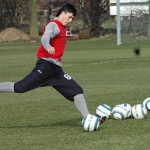
Click Here to Listen to Podcast Click Here for the Show Notes
Continue reading#021 Getting a Jump Start to the Season
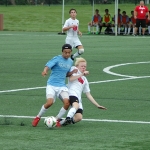
Click Here to Listen to Podcast Click Here for the Show Notes
Continue readingDealing with Balls Cut Back from the End Line
By Patrick Kasperitis -
A common soccer tactic is for the attacking teams to have a player drive towards the end line and play a ball at a backwards angle toward the top of the 6-yard box. This type of play allows for the ball to already be behind the defenders and allows the attacking players to be able to attack the ball at an angle that is moving away from defenders and the goalkeeper. Plus because of the fact that this ball is often driven from a close distance it can be difficult for the goalkeeper to hold on to it. This exercise will
Continue readingGetting Back to Your Line
By Patrick Kasperitis -
This exercise set looks at the goalkeeper’s ability to not only deal with a cross, but to get back onto their line in order to deal with any save that might come from having to punch or tip the shot.
Set-Up
Place cones off to the side of the penalty area in line with the penalty spot. Using the Line for the end of the penalty area (or setting a cone 6 yards away from the gates) the server will toss the ball up in the air for the
Playing Out with the Goalkeeper
By Patrick Kasperitis -
The modern goalkeeper is required to use their feet almost more often than their hands. Players like Manuel Neuer (Bayern Munich FC and German National Team) and Hope Solo (Seattle Reign and US Women’s National Team), whose stories involve relatively late changes in position to playing as a goalkeeper made their ability to play with their feet seem almost natural. On the opposite side we see fantastic shot stoppers like Simon Mignolet, who plays for Liverpool FC in England, come under immense criticism for his relative short comings playing with his feet.
The skills they use to help their team to play out of the back are things that we can train. We want to try to replicate situations they might see in the game. One of these examples is when the goalkeeper is asked to swing the ball from side to side. Our defenders in front of us are under pressure, we want our team mates to be able to be comfortable playing the ball back to us so that we can get to the
Continue reading

